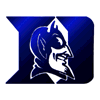|
The Story of the Duke Mascot
Duke's Blue Devil
During World War I the Chasseurs Alpins, nicknamed "les Diables Bleus,"
were well known French soldiers. They first gained attention when their
unique training and alpine knowledge was counted upon to break the
stalemate of trench
 warfare in their native region of the French Alps.
Unfortunately the Vosges Campaign in March, 1915, failed to alter the
status quo even though the Blue Devils won accolades for their courage.
However, their distinctive blue uniform with flowing cape and jaunty
beret captured public imagination. When the United States entered the
war, units of the French Blue Devils toured the country helping raise
money in the war effort. Irving Berlin captured their spirit in song
describing them as "strong and active, most attractive . . . those
Devils, the Blue Devils of France." warfare in their native region of the French Alps.
Unfortunately the Vosges Campaign in March, 1915, failed to alter the
status quo even though the Blue Devils won accolades for their courage.
However, their distinctive blue uniform with flowing cape and jaunty
beret captured public imagination. When the United States entered the
war, units of the French Blue Devils toured the country helping raise
money in the war effort. Irving Berlin captured their spirit in song
describing them as "strong and active, most attractive . . . those
Devils, the Blue Devils of France."
As the war was ending in Europe, the Trinity College Board of Trustees
lifted its quarter-century ban of football on campus. After playing an
intramural class schedule for one year, Trinity began intercollegiate
competition in 1920. That first year the traditional nomenclature of the
Trinity Eleven, the Blue and White or the Methodists (as opposed to the
Baptists of nearby Wake Forest) described the team. In September, 1921,
the student newspaper, The Trinity Chronicle, launched a campaign for a
"catchy name, one of our own possession that would be instantly
recognizable nationwide in songs, yells and publicity."
At a campus pep
rally to stir up enthusiasm it was pointed out that Georgia Tech was
gaining recognition as the "Golden Tornados" and that rival North
Carolina State College had recently adopted the name "Wolf Pack." There
were numerous nominations including Catamounts, Grizzlies, Badgers,
Dreadnaughts, and Captains which was in honor of the well-liked Coach W.
W. "Cap" Card. Believing a choice utilizing the school colors of dark
blue and white to be appropriate, the newspaper editors urged a
selection from among the nominations of Blue Titans, Blue Eagles, Polar
Bears, Blue Devils, Royal Blazes, or Blue Warriors. None of the
nominations won strong favor but Blue Devils apparently had enough
support to elicit the criticism that it would arouse opposition on the
Methodist campus "for obvious reasons," and that it might prove risky
and jeopardize football if a controversial name were used at that
particular time. The football season passed with no official selection
of a name.
As the campus leaders from the Class of 1923 made plans for their senior
year, they decided to select a name since the desired results by
democratic nomination and vote had been inconclusive. The editors of The
Archive and The Chanticleer, two of the other student publications,
agreed that the newspaper staff should choose a name and "put it over."
Thus William H. Lander, as editor-in-chief, and Mike Bradshaw, as
managing editor, of The Trinity Chronicle began the academic year
1922-23 referring to the athletic teams as the Blue Devils. Their class
had been the first post-war freshmen and the student body was full of
returning veterans so the name needed no explanation. Acknowledging that
it was somewhat unpopular, they nevertheless believed it to be the best
name nominated. Neither the college press nor the cheerleaders used the
name that first year. In fact, The Chanticleer made fun of the selection
and process by quoting someone saying "We will use blew devvies even if
no one else does." Much to the editor's surprise no opposition
materialized, not even from the college administration. The Chronicle
staff continued its use and through repetition, Blue Devils eventually
caught on.
Today the origin of the university mascot is virtually forgotten even
though its instant, national recognition has long been established. With
the popular Red Devil mascot frequently being challenged throughout the
country, the origin of Duke's Blue Devil is one of the most often
requested items of information in the University Archives. Questioners
are universally surprised to discover its origin is more military and
patriotic than religious.
Home Page 
|

